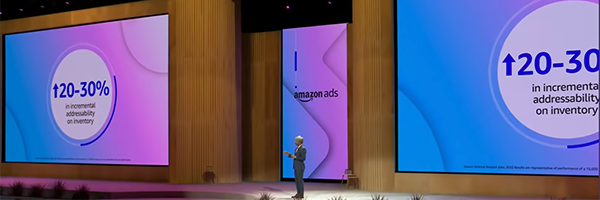 |
||||||||||||
|
||||||||||||
| Amazon Boosts Its Ad Business |

Image sourced from Amazon Ads Unboxed 2022
|
| It looks like Amazon is fed up with its number three spot in the ad tech triopoly. That's why the etailer's plans for beefing up its advertising ecosystem have some industry insiders predicting the company taking over Facebook's number two spot, especially since the social media giant has experienced significant revenue losses and made major missteps. Amazon recently announced, at its Unboxed 2022 Conference, a series of ad tech updates, new ad formats, and automation services all with an eye toward building up its self-serve platform and data clean room. Sponsored Display Ads For Brands Not Selling on Amazon: Amazon is soon offering sponsored display ads to brands that don't sell on their platform — like restaurants and hotels. Currently, in beta on Twitch this feature was previously only available to brands selling products on Amazon. Rewarded Sponsored Display Ads: Also currently in closed beta, is the ability for advertisers to add Amazon shopping credits to their creative, where customers receive the reward by taking the desired action. Amazon's Marketing Cloud Quadruples: Amazon's data clean room, where brands can introduce their data and match their data to analyze and plan campaigns, has quadrupled its customer base in the past year. Plans to increase its effectiveness, in terms of targeting and measuring capabilities, include the addition of Sponsored Display and digital subscription events, more pre-built instructional queries, and the ability to manage demand-side platform (DSP) audiences across all Amazon ad channels, from Whole Foods to Twitch, according to MediaPost. At this point, Amazon's Marketing Cloud's success could prove that data clean rooms are more than just a trend. |
| Amazon is becoming a crucial player in the advertising ecosystem. Their ad business has grown tremendously, 18% year over year in Q2, to $8.76 billion. Plus, the company's retail media network is on the verge of exponential growth, and it now incorporates out-of-home ads into their DSP. Inventory will soon be available on screens in stores like Amazon Fresh through managed services, which are not a part of the self-serve ads system. For years, we've talked about Amazon taking on the duopoly. Could 2023 be the year of the takeover? |
| The Opt-Out Consumer Should Be Better Informed |
| While consumers play an important function in the advertising ecosystem, over the past couple of years there has been a concerted effort to guarantee they have more choices about sharing their data with media companies and brands. One of the most common options is enabling consumers to opt out of sharing their data. Recently, Permutive held a webinar discussing consumer consent and opt-out capabilities, where industry experts pointed out several trends and issues. Trends: Publishers tend to focus on the revenue aspect. Richard Reeves, Managing Director at AOP pointed out that most people seem to focus solely on the economic impact of the opt-out function. Although, he advises attention should be expanded well beyond that. “In terms of impact, it’s not just the monetization challenge you need to consider, it’s also the impact on resources, as well as the complexities associated with monitoring and enforcing supply chain behaviors. It’s also quite a challenge for publishers to understand the different interpretations and applications across different DPAs in multiple territories.” The industry needs to be better at educating consumers on how handing over their data can benefit them. According to Stephen Bonner, Deputy Commissioner, Executive Director of Regulatory Future and Innovation at the ICO, “Privacy notices tend to share what the benefits are to the business, rather than making it clear what the value is to consumers.” |
| Opt-out capabilities are one of the most widely used functions to protect user data. Alongside the privacy notice of many brands, consumers are given a “notice about how their personal information will be collected, used, and shared and then tells the consumer what choices they have.” Many will also give the consumer the choice to opt out of these actions. While this is a way to give power back to the consumer, many worry that there could also be some downfall for the individual consumer. For example, some argue that consumer choice has not been able to work to its full potential because consumers are not always knowledgeable about how their data is used and shared in the first place. There is also the issue of consent fatigue. Even the most dedicated consumer will “click accept so they can read that article and move on with their life.” Therefore, teaching the consumer about the data exchange process is a part of giving them back their power. Every part of the ecosystem–publisher, advertiser, consumer, vendor–needs to work together as an ecosystem to make sure consumers' needs are met. “We want to see a world where people’s enduring preferences can be expressed and respected…without having to force the poor consumer to jump through pages of legalese,” said Bonner. “The status quo isn’t working well for anyone, and we’re in one of those few moments where there is an opportunity, with the deprecation and other changes occurring, to reinvent some of this, so it works brilliantly for many more of the people involved.” |
| Consent Summit 2022: Balancing Compliance and Revenue Growth |
| As privacy regulations mount, the ad tech industry is scrambling for compliance. While there are ethical dilemmas at play, there is also a concern about balancing revenue goals with compliance goals. For many, the new privacy regulations are hindering companies from connecting with a massive audience. At LeadsCon's Consent Summit 2022, the conference hosted a panel entitled “Balancing Compliance and Data Privacy Issues With Your Growth Goals.” On the panel, two litigators and ad tech executives discussed how to create a compliance policy at your company that does not conflict with your growth goals. They offered several pieces of advice: Compliance should be discussed at the beginning. Speak to your legal team from the beginning so you do not have to face the consequences later down the line. This includes forming a strong relationship between the legal team, c-suite, and senior leadership team. This will allow the legal and compliance team to understand the company's goals and create a compliance policy with those goals in mind. Pay close attention to compliance trends. As the industry has seen, privacy regulations can change on a dime. Third-party cookies might have been extended but there is a huge possibility of them going away in the near future. Several state privacy regulations are in play and ADPPA could be passed very soon. Staying on top of these trends will help you future-proof your business. |
| The FTC and other state and federal regulators are cracking down on anyone who is willfully or unwillfully negligent in complying with privacy laws. In fact, at the beginning of the panel, Terance Gonsalves, Partner at Alston & Bird LLP, alerted the audience about a massive uptick in privacy litigation. “There's been a significant uptick in data breach litigation over the last five years and we have almost become immune to it when we see it in the news,” says Gonsalves. “But with every one of those comes significant litigation and very often some sort of regulatory investigation, and it costs the company a lot. It's generally millions of dollars.” For example, we reported in September about the FTC's lawsuit against Kochova for releasing personal information about their customers. They were selling information from sensitive locations such as reproductive health clinics, places of worship, and other personal locations. Not only does this lawsuit detail the trust the company broke with their audience, but it could also leave them with a massive fine. Staying on top of your privacy compliance is an essential part of making sure your business stays afloat. |
| Around the Water Cooler |
 |
Here's what else we're chatting about WPP's Growth Fueled by Tech and Digital Marketing Services With revenue for. the third quarter reaching $4.14 billion, WPP has raised its EOY forecast to between 6.5%-7%. Chief executive Mark Read credits the rapid growth in the application of technology and digital marketing services. (ADWEEK) Alphabet's Slow Ad Growth Spark Fears Across Industry Advertisers continue to cut back ad spending on Google and particularly on YouTube, which is the company's cash cow. Since the company is still the market leader, their losses have sent ripples of worry throughout the industry. Facebook has also experienced an ad revenue slump for two consecutive quarters. Will Google and Facebook's reign as the duopoly come to an end? (Reuters) |









